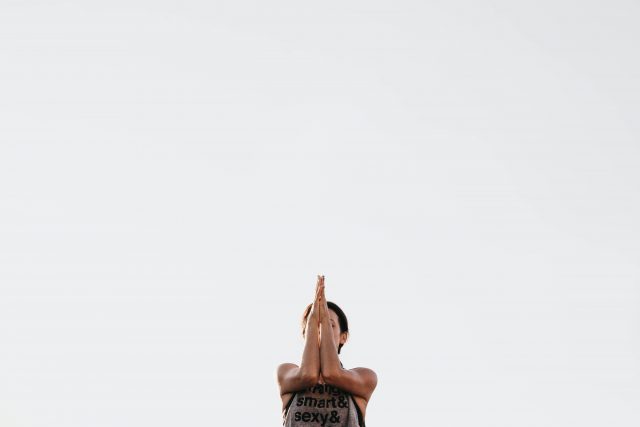
When you lose control of your emotions, it is important to stop analyzing them and shift your attention to the body. It is inextricably linked with our soul. Body practices affect our emotional state and with their help we can stabilize it. The techniques collected below can be easily repeated and the effect is immediately noticeable.
Practice “Grounding”

Effect: relaxation, reduced anxiety, control over emotions, a sense of stability and security.
Operation time: 3-5 minutes.
A psychological relaxation technique used to regain control over what is happening, return to reality, and feel your body and support.
- Stand with your feet shoulder-width apart and support from three points: heel, little toe, thumb.
- Bend your knees a little so that they become soft and shock-absorbent. The pelvis should not protrude, so it needs to be bent.
- Relax your upper body – shoulders, neck, head. On a relaxed neck, you can stretch your head slightly forward and your arms along the torso.
- Focus on your feet. Imagine growing into the soil.
- Ask yourself: “Am I leaning inward, on my toe or on my heel? What temperature are my feet at? Is the temperature different in the right and left leg?
- Breath. Take a deep breath in four times and the same soft exhalation. Take a break from breathing.
- Try to stay like this for 5-7 minutes. Most importantly, feel the support in your feet and breathe evenly.
Breathing exercise “4-7-8”

Effect: anxiety reduction, relaxation, help with insomnia.
Operation time: 2-3 minutes.
The state of the nervous system directly depends on breathing. Breathing with the upper cell is typical for stressful situations, so it is important to move to the lower part (stomach) to relax the body.
- Get into a comfortable sitting or lying position. The gaze must be scattered without focus, otherwise the eyes may be closed. Focus on your breath.
- Press the tip of the tongue to the palate, open your mouth slightly and exhale fully.
- Close your mouth and mentally take a deep breath through your nose, counting to 4. Fill your lungs, starting from the lower abdomen.
- Hold your breath while counting to 7.
- Exhale slowly through your mouth, counting for 8 seconds. Release all your worries and worries as you exhale.
- Take a short break and repeat the technique 10-12 times.
Anchor drop application

Effect: control over emotions, a return to reality, the development of stability, a sense of support.
Operation time: 3-5 minutes.
An effective resurfacing technique from Russ Harris, Acceptance and Consistency Therapy Instructor. By focusing on the space around us, we move away from inner experiences and anchor in the present moment.
- Name the first thoughts and feelings that come to mind. For example, “I am thinking about paying off a debt”, “I feel tired”, “I have a headache”, “I am afraid”.
- Pay attention to the body – how you sit, breathe, feel the support under your feet, the surface of the chair under you.
- Move your arms and legs, inhale and exhale, straighten your shoulders, put your feet more stably. Through the body, we regain control over our actions.
- Pay attention to what is around you – the room, people, objects, smells, sounds, textures. Find things you can touch and touch them. Find things you can smell. Find things you can hear. By being aware of the present moment, preoccupied with it, we can choose where to direct our attention.
Alternate nostril breathing

Effect: feeling of calmness, concentration.
Operation time: 3-5 minutes.
A breathing method that activates the energy circulation in Indian yoga. Depending on your breathing rate, you can both relax and cheer up. Below are the instructions for the first option.
- Sit in a comfortable position with your back straight.
- Close the right nostril with the thumb of the right hand and inhale deeply from the left. At the peak of the inhale, close the left nostril with your ring finger and exhale through the right.
- Try to fill and empty your lungs to the limit.
- Perform 5 such cycles, and then change the nostril.
- Then take 5 breaths through both nostrils.
- Do not rush and do not be forced, breathe easy.
acupressure

Effect: relief of muscle tension, stress, anxiety, sense of calm.
Operation time: 5-10 minutes.
Acupressure came to us from traditional Chinese medicine and involves pressing certain points of the body. These are called acupuncture. One of the main points – Yin-Tang – is located in the middle between the eyebrows, and you need to work with it.
- Take a comfortable position.
- Place the thumb or index finger of the right hand between the eyebrows.
- Press this point, making circular movements for 5-10 minutes. The pressure should be light and not cause discomfort.
Transcendental meditation

Effect: peace of mind, clarity, concentration.
Operation time: 15-20 minutes.
Meditation keeps us in the present without being emotionally involved in worrying about the future and thinking about the past. It clears the mind and provides sleep-like rest. The transcendental meditation technique was introduced by Maharishi Mahesh Yogi in the mid-1950s. After that, celebrities from the Beatles to David Lynch began practicing this type of meditation. The first thing to do before practicing is to choose a mantra, a word to pronounce in your mind, and then follow the directions.
- Take a comfortable position. Close your eyes if it will make it easier for you to relax.
- Start repeating your chosen mantra to yourself.
- Don’t worry if you have many thoughts in your head. Keep focusing on the word and repeat. Gradually thoughts will disappear.
- Try doing this for 15-20 minutes twice a day.
Technique “Shaking”

Effect: concentration, mental clarity, relief from muscle blocks.
Operation time: 10 minutes.
It’s an ancient practice that energizes and helps release muscle blocks that we’ve now accumulated enough. If you give the body a good shake, the mind will be calmed and cleared. Today, the technique is used in dance movement therapy and sensory release training.
- Lie on the floor.
- Start swinging the limbs one by one – right arm, left arm, leg, etc.
- Start shaking your whole body, raise your hands up in different directions for 3-4 minutes.
- Get up again and be calm. Relax.
Source: People Talk
Mary Crossley is an author at “The Fashion Vibes”. She is a seasoned journalist who is dedicated to delivering the latest news to her readers. With a keen sense of what’s important, Mary covers a wide range of topics, from politics to lifestyle and everything in between.





